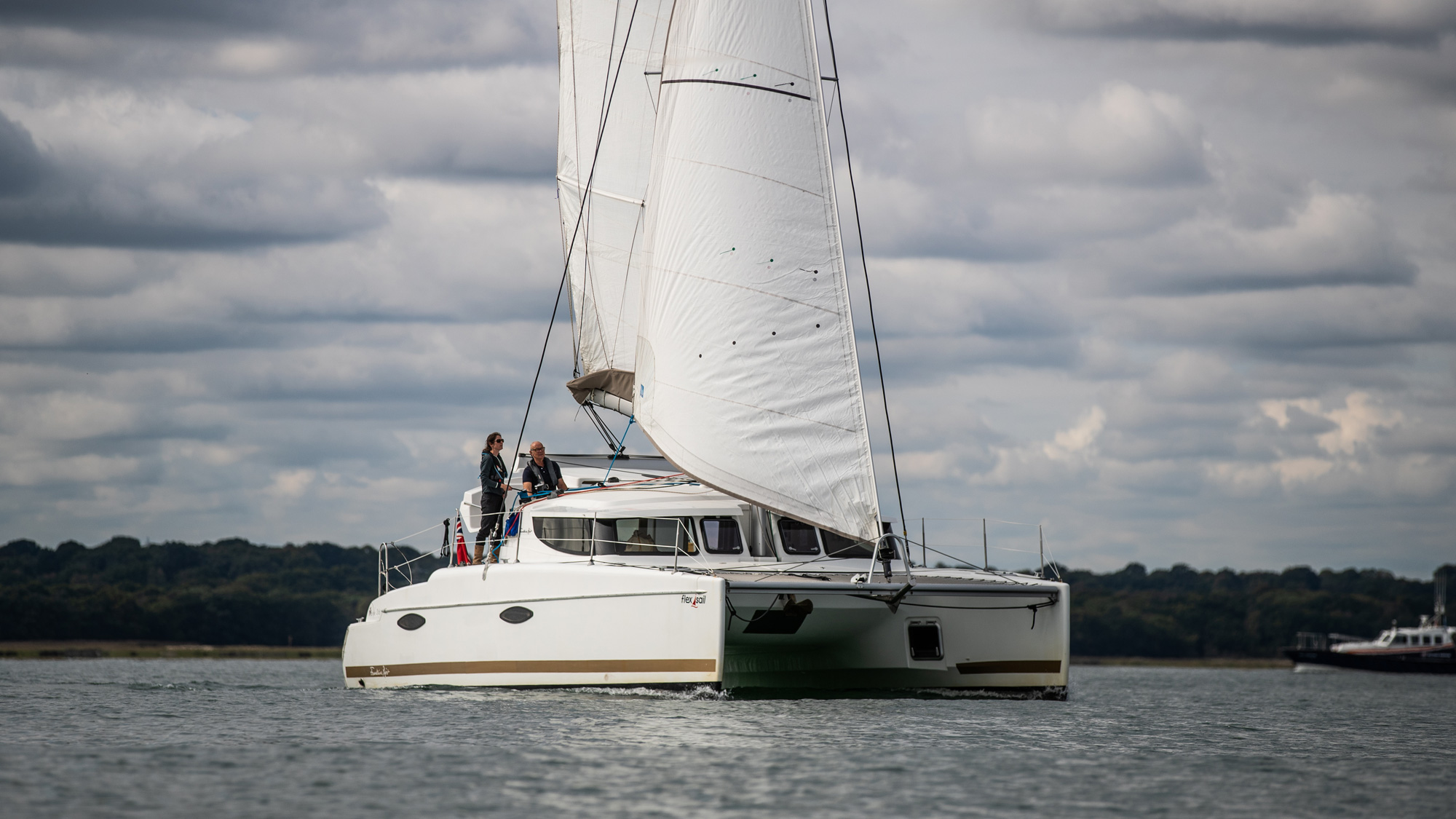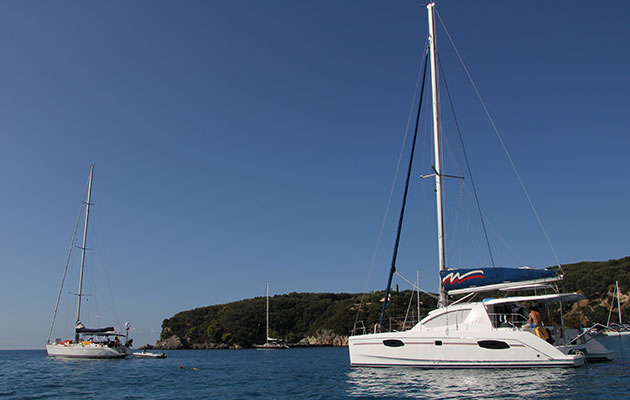For their size, trimarans can punch well above their weight in speed, cruising potential and fun. Monohull sailor Theo Stocker gets to grips with how to handle one
Humans tend to gravitate into tribes of like-minded enthusiasts, enjoying the encouragement, support and sense of identity, while often looking askance at others; sailors at motorboaters, cruising sailors at racers, monohull sailors at raft, I mean, multihull sailors, and everyone looks askance at jet-skiers.
Large cruising catamarans (40ft now counts as a small one) are a world apart from monohull sailing, but there’s a sub-tribe of sailors dedicated to life on three hulls and builders such as Dragonfly, Corsair, Farrier, and Astus give them plenty of choice.
I’ve been sailing a 22ft (7m) Astus 22.5 this season, with just enough space for a family of four and a minimum of creature comforts. Thanks to her VPLP-designed hulls and 650kg all-up weight, we can sail upwind at 7-plus knots and downwind at over 10 knots with ease, all on a roughly even keel, while the kids play Duplo down below. It can also be beached and is towable behind a car.
Having, it seems, caught the trimaran bug, I wanted to get better at sailing and handling the boat, but my monohull sailing experience and habits were proving something of a hindrance, so we sought advice from some existing trimaran owners, and well as the UK’s top multihull sailors.
Much of the advice will apply to all multihulls, whether two or three-hulled, while other parts are just for small trimarans. I also found that brushing-up some of my rusty dinghy sailing skills helped get my head around what we were trying to do.
To try out our expert tips we went out sailing to see what difference they made. On the day, we got a solid Force 4-5 southwesterly, averaging 16 knots, but fluctuating between 12 and 20 knots true.
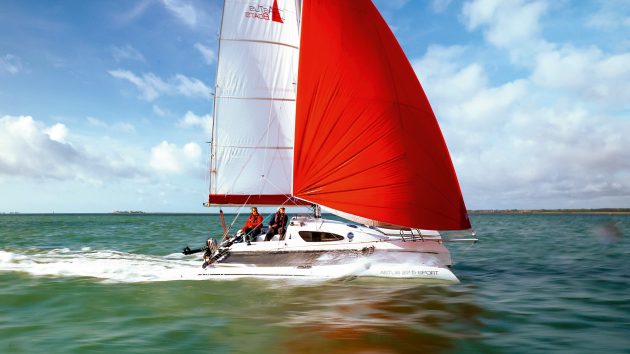
Blasting about on a sporty trimaran is a whole world of fun, but is much calmer than it looks
Trimaran sail trim
One of the biggest differences between a cruising monohull and a multihull is how the mainsail is trimmed. Leech tension on a yacht is often largely controlled by the kicker and the backstay, while the mainsheet sheets the mainsail in and out, predominantly controlling the angle of the boom to the centreline, and there may be a short traveller.
On a mulithull, however, there’s more than enough space for a good, wide traveller. Those who sail on performance monohulls will also be used to this. The sail shape is mainly controlled by the mainsheet, and the traveller then moves the boom towards or away from the centreline.
This is exaggerated on a multihull which has wide shrouds, swept well aft with no backstay, making space for a powerful square-top mainsail with full-length battens. There’s no backstay to bend the mast and flatten what is anyway a pretty rigid mainsail.
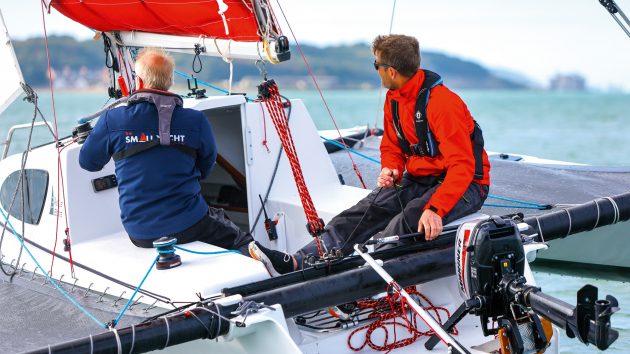
The mainsheet purchase creates enough power to control the leech of the square-top mainsail
Depowering a trimaran
Sailing on a monohull, heel and weatherhelm and eventually a broach give loads of warning that you’re pushing too hard. With straight hulls and little heel, those warning signs don’t really apply to multihulls.
In reality, however, there are a host of warning signals that it’s time to back-off; they’re just a bit different. Even then, there’s still a large safety margin before you get close to danger.
By way of reassurance, with the boat powered up on a beat, Hein, from Boats on Wheels, the boat’s owner, stood on the leeward hull and lent on the shrouds. Even as his feet got wet and the wind gusted at the top of Force 4, the boat didn’t bat an eyelid, thanks to the huge buoyancy of the floats.
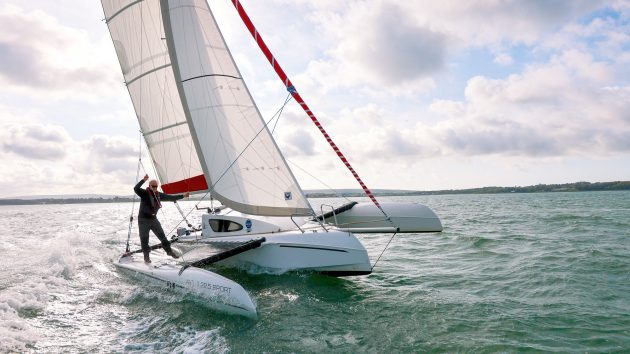
Even with a person on the leeward float the boat was extremely stable
On the water – sail trim
My first inclination was to point the boat as high upwind as possible, pin the sails in and go for height. Doing that resulted in a not-terrible boat speed of 5-6 knots and a good pointing angle.
Free off by a handful of degrees however, and ease the sails just a smidge, and the speed leapt up to 8-9 knots – over 50% more; a huge increase. So, don’t pinch. If you had a decent chartplotter on board, you could find your optimum speed to angle using velocity made good (VMG).
I was also tempted to pinch in the gusts, but it’s better to hold your course and let the speed increase until the main needs easing.

On the wind, it’s time to get the boat fully powered up
If that’s the case, drop the main down the traveller an inch or two or ease some twist into the mainsail and it makes all the difference in the world, but not so far that the top battens fall away and invert – that really isn’t fast. Push too hard and the boat will slow down, largely from the drag of submerging the leeward float and crossbeams. If you’re still overpowered and the main is luffing, it’s time to reef. Downwind is different, but we’ll get onto that later.
After we put a reef in the main, our boat speeds upwind remained largely the same, and the boat was much happier. I came away feeling reassured that even a little trimaran like this would be pretty difficult to capsize, and there were always plenty of warning signs telling me to take my foot off the pedal a little.
Article continues below…
Catamaran sailing skills: Mooring and anchoring a multihull
How do you make an average passage speed of 7 knots, fit in three double cabins and a huge saloon…
Monohull or multihull: which is best for blue water?
As former editor of Yachting World, David Glenn has plenty of experience of both monohull and multihull cruising. Here he…
Tacking and gybing a trimaran
Everyone knows that multihulls don’t tack as well as monohulls. Straight hulls and wide beam don’t lend themselves to turning, especially when coupled with the displacement and fixed keels of big cats. Trimarans are a little easier, with a single central daggerboard to act as a pivot, and one or other of the floats will generally be clear of the water. On the downside, light displacement means that there isn’t much momentum to keep you going through the turn and plenty of windage to stop you.
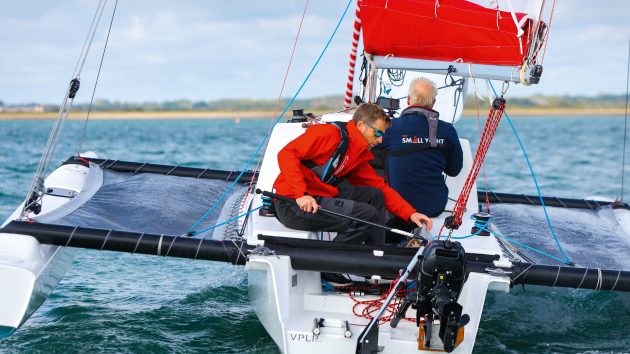
On a trimaran the central daggerboard helps the boat to turn by providing a central pivot point that catamarans lack
Speed is your friend. Build speed up before the tack to give you as much momentum as possible. The helm needs to steer positively into and through the turn, and if necessary, keep the jib backed on the new windward side to help the bow through the wind. Don’t worry about scrubbing speed off, but you don’t want to get stuck in irons.
When it comes to gybing, speed is again key. The turning bit isn’t going to be an issue as you’ll be scooting along, but the faster you’re going, the less load there will be on the sails. The more you slow down, the more the true wind will pile up.
Trimaran sailing skills
Tacks took a bit of practice. It felt plain wrong to jab the tiller across the boat, slamming a big break on in the water but I ended up putting us through the tacks far too slowly, losing a lot of speed. A more aggressive approach worked better. On the Astus, the traveller was between me and the tiller, so the tiller extension needed to be swung around the stern behind the mainsheet onto the new side.
Similarly, old habits of controlling a gybe needed to be modified. With the asymmetric set, we were planing at well over 10 knots, and the ideal is to stay on the plane. Heading dead downwind and centring the main lead to a more violent manoeuvre than flying into the gybe as fast as possible and, as the boom was never that far out thanks to the apparent wind angle, it didn’t need much extra controlling.
Coming up onto the wind after the gybe helped the asymmetric around the front of the jib and to fill on the new side. Stay too deep and it’ll get blanketed by the main. Once we had built up some apparent wind, we could bear away again.
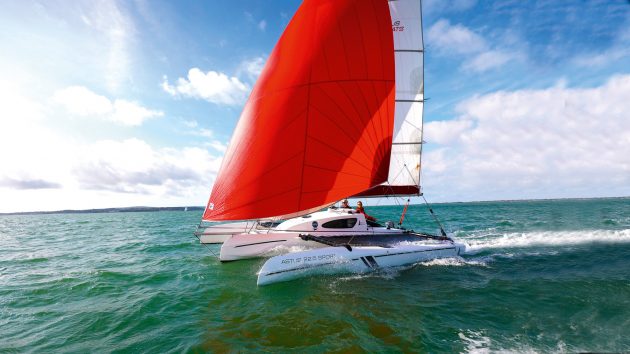
You’ll be on a course deep downwind before you know it, hitting speeds in the double digits
Downwind in a trimaran
Upwind cruising may be fun in a multihull, but bearing away and going with the wind is what it’s all about. Easily-driven hulls, a generous sailplan and light weight mean you can be up and planing, leaving displacement boats wallowing in your wake.
The big difference comes from apparent wind. If you’re in a boat that can do 15 knots downwind in 20 knots of true wind, the resulting wind angles can really mess with your head.
To get going then, says Brian Thompson, ‘Use those leech tell-tales again when sailing downwind and reaching to set the correct twist through the mainsheet, and use the traveller to set the correct angle of the whole sail to the wind.’
As the wind and your speed builds, bear away and trim the main accordingly.
In theory, you shouldn’t need to ease the traveller at all, but you may need to if you want to sail deep downwind. As the gust fades, you’ll find the boat slows down, so you can come back up towards the wind a little to pick up some more breeze, and then bear away as you accelerate again.

Bear away as the boat accelerates. Your course will be something of a slalom as you look to keep a consistent wind angle
This results in something of a ‘slalom’ course, and will also be accentuated if you’re sailing down waves, but that’s all quite normal for apparent wind sailing. Ultimately, you’re looking for a consistent apparent wind angle, even if the resulting wake isn’t straight.
It’s worth remembering that apparent wind reduces the felt effect of the wind, so you need a sailplan to suit the true, not apparent wind speed.
I found that the boat was more sensitive to having a balanced sailplan and trim downwind than upwind, largely because you’ve got almost double the canvas up, with the bowsprit as an extra lever. When weather helm built, I needed to ease the mainsheet to increase twist to depower so that I could bear away. I must admit, getting the boat balanced, sailing fast and light on the helm at 15 knots was something I came away feeling I needed more practice at.
Reviewing the images, I suspect the asymmetric was sheeted in too hard, with too much twist in the main.
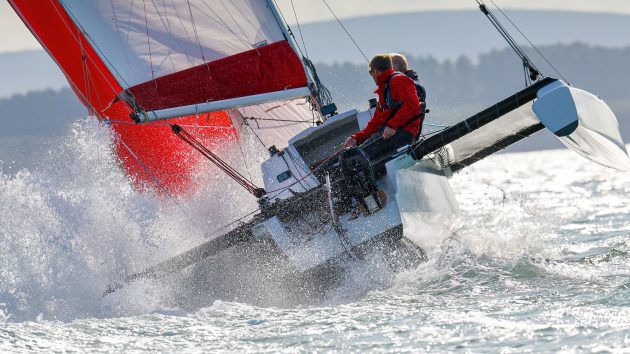
Getting a float fully submerged is when it’s time to back off
On the water
Unfurling the gennaker worked best on a beam reach, giving plenty of airflow over the sail to help it fully unfurl. This was also roughly the fastest point of sail, ideal for getting up some speed for apparent wind sailing. We mostly had the sails set for a close reach, even when we were beyond 120º off the true wind on a broad reach.
It was possible to soak deeper downwind, but lose the apparent wind benefit downwind and our speed dropped off dramatically, prompting us to point a bit higher to find some more speed.
As the boat powered up, it paid to hold a slightly higher angle than I would have done in a monohull for the boat to properly take off and get up into double digit speeds – topping out at 15 knots. Lymington to Cowes would have taken us just half an hour at that speed. It’s easy to give yourself a heck of a beat back!
We were sailing on a pretty flat day, so didn’t have to contend with any waves to speak of. On the recent RTI this is what caused the capsizes of at least two multis, a sobering reminder that you need to sail much more conservatively in lumpier conditions.
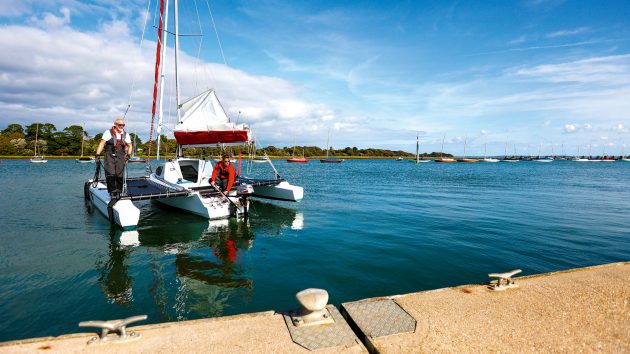
The bows want to point downwind, so a stern-first approach works with rather than against the boat
Coming alongside
A 650kg boat with no draught and plenty of windage feels dreadfully skittish when manoeuvring in confined spaces. Straight hulls with no forgiving curves and fragile-looking sharp bows make berthing tricky. You’ve got a couple of advantages on your side, however. In the Astus, the floats are at pontoon height making stepping off easy.
Whether you have an engine in each hull of a cat, or one in the central hull of a tri, there’s also a lot more leverage to play with to turn the boat and drive her on or off the pontoon. A steerable outboard gives you even more options.
If the boat has a lifting keel or daggerboards, put them down if there’s enough depth to give you a pivot and to resist drifting. Think about getting corners onto the pontoon, rather than putting the boat alongside. On tris, you won’t be able to get to the bow to fend off as it’s too narrow. You can rig a fender up forwards on a line, and two fenders are enough on the flat sides.
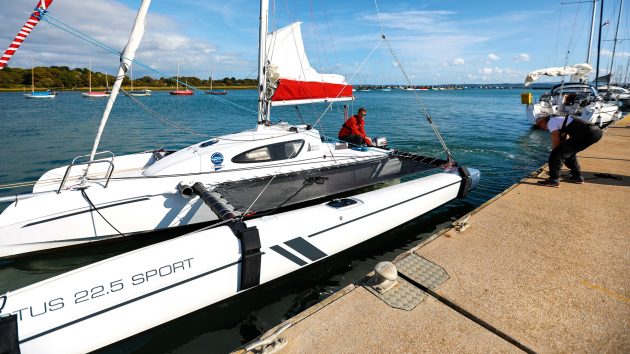
Steering with the outboard towards the pontoon will drive the stern in more; steer away to drive the bow in more
Offshore wind
Coming onto the pontoon with wind blowing off, it worked well coming in stern first. If there’s a tide running, you’ll want to be heading into the tide, so find a spot down wind and down tide to start your approach so you come in at an angle.
On our first attempt we had a bit of tide under us to start with so we came in at a much steeper angle, almost 90º, although this worked out OK in the end.
The crew could then step ashore, taking a line from the stern quarter round a cleat.
Drive forwards against the line and the bow will obediently drive up towards the pontoon, bringing you flat alongside. Getting off was simple, releasing the bowline, and allowing the bow to swing out the before slipping the stern line.

Coming in astern and stopping upwind of the berth meant the bows blew towards the pontoon far to quickly
Onshore wind
Getting onto and off a pontoon with onshore wind proved rather trickier. On our first attempt we came in stern first. The issue was that once we were just upwind of our desired berth and stopped, we lost steerage and the bow immediately blew off with alarming speed towards the pontoon.
Going ahead would only increase the force of the impact, while going astern only increased the bow’s sideways drift. I managed to back out without smashing the bow, but only just, and ended up awkwardly stern to the wind with the bows pointing at the pontoon.
On our second attempt we came in bows first but having aimed at the berth, I had to motor the stern to leeward to stop the bow hitting, making for a rather forceful coming alongside.
On take three, I came in forwards and began ferry gliding towards the berth early, keeping the bows to windward of the stern. Being able to steer with the outboard meant I could go ahead to keep the bow up, and go astern with the engine pulling the stern down toward the pontoon. In this way, it was possible to come in pretty well controlled and parallel to the berth.
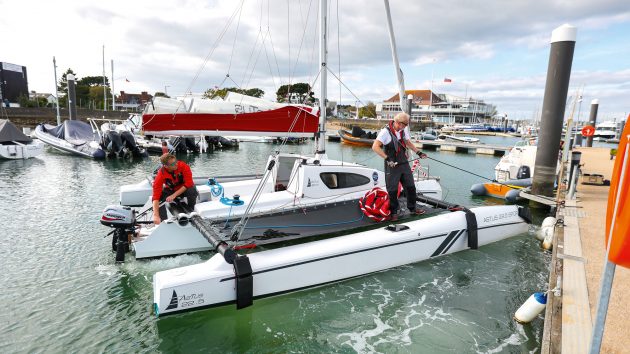
To get out, motoring astern against a bow line pulled the entire boat clear before slipping the line
Leaving was a different proposition all together, as I didn’t want to drag the bow along the pontoon, or to drive hard onto it to spring off. Instead, we rigged a slip-line from the forward cross beam. Going astern against this, and then turning the engine towards the wind, I could pull the stern, and the rest of the boat, out and away from the pontoon.
Keeping power on astern, once we’d reached a decent angle, we slipped the line and went astern, finding steerage way almost at once, with the bow following obediently in our wake with more control than I had anticipated.
Whether the wind is blowing onto, or off the pontoon, you want the engine to be driving or pulling the boat off the pontoon with a line on the corner you are going away from. That way you avoid point-loading fine ends where it’s hard to fender.
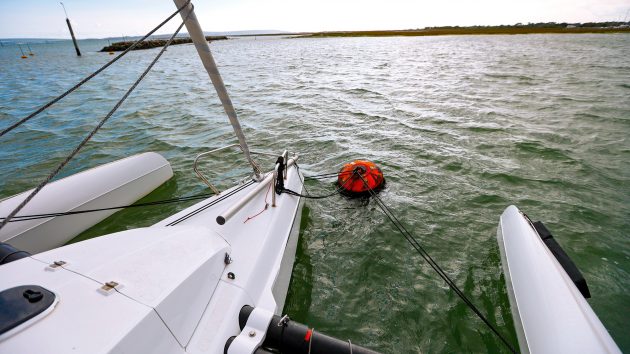
You’ll want a bridle to reduce swinging, but keep the pick up lines on the bow as backup
Anchoring and mooring a trimaran
While mooring a catamaran is complicated by the lack of a central bow, things should be simpler on a trimaran, and they are, mostly. Picking up a mooring buoy from the main hull bow with a low freeboard and dropping the pick-up line onto a cleat is easier even than a monohull.
The bow may be narrow, but for any lines that pass through a ring on the buoy, you still need to take it back to the same cleat to avoid chafe. That should be it, but windage from the two extra bows and the lack of keel mean the boat can dance merrily around the mooring buoy in a breeze.
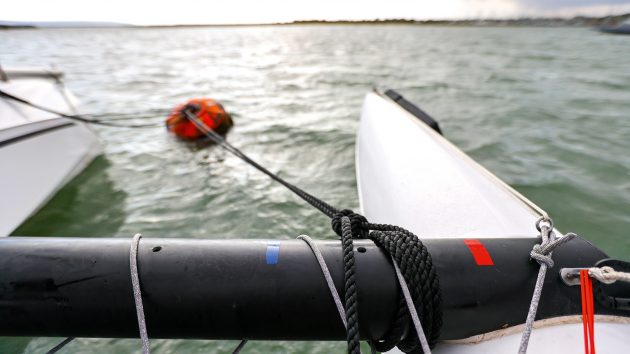
Rig the bridle so the buoy sits to one side to stabilise the boat
On the water
In practice, we found that a trimaran benefits from a mooring bridle in the same way that a catamaran does. It can’t be rigged from the floats’ bows, as there are no mooring cleats, so a line passed around the outboard ends of the forward beams gave a pretty good angle, again with long lines passed through the mooring and back to the same side. The main pick-up lines stay as a safety backup.
The other trick is to rig the bridle asymmetrically so that the buoy sits to one side or the other, just enough to not be dead head to wind, making it much more stable in the wind.
On the plus side, the lack of draught or keel means that you’ll nearly always be lying head to wind, so the cockpit remains nice and sheltered whatever the tide’s doing.
We ran out of time on the day to try anchoring, but rigging a bridle, effectively a long snubber to a point on the anchor chain in a similar way wouldn’t be tricky.
If you needed not to swing, or to behave more like deeper boats nearby, hanging a bucket over the stern can help, or there’s always anchoring with a kedge, either out ahead in a V, or in line astern.
Enjoyed reading this?
A subscription to Yachting Monthly magazine costs around 40% less than the cover price.
Print and digital editions are available through Magazines Direct – where you can also find the latest deals.
YM is packed with information to help you get the most from your time on the water.
-
-
- Take your seamanship to the next level with tips, advice and skills from our experts
- Impartial in-depth reviews of the latest yachts and equipment
- Cruising guides to help you reach those dream destinations
-
Follow us on Facebook, Twitter and Instagram.





